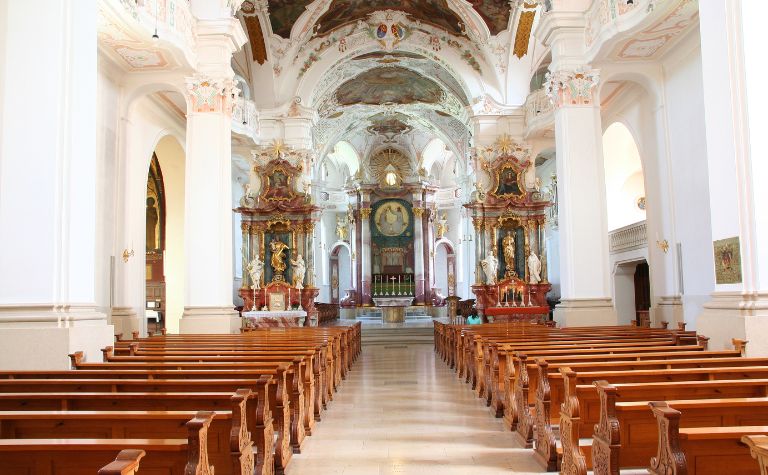Roman Catholicism, Protestant Christianity, and Eastern Orthodoxy make up the three historical branches of the Christian religion. Catholicism and Protestantism are, by far, the two largest branches. Each tradition can be found all over the world. Given their size and influence, many people wonder what their similarities and differences are.
Roman Catholics and Protestants believe in the Trinity, the human race’s sinfulness, the Bible’s inspiration, and the Second Coming of Christ. Important areas of disagreement include the nature of the Eucharist, the authority of the pope, and the definition of justification in relation to salvation.
What accounts for the similarities and differences between Catholicism and Protestantism? Is Catholicism or Protestantism larger? How do the traditions’ beliefs about the Bible, Jesus Christ, the Holy Spirit, baptism, and the Lord’s Supper compare? Keep reading to learn the answers to these questions and others.
Also, see Roman Catholic vs. Eastern Orthodox: What’s the Difference? to learn more.

Comparison: Roman Catholicism and Protestant Christianity
Roman Catholicism traces its origins to Jesus Christ, and the Apostle Peter, who the church teaches was the first bishop of Rome. Protestantism also traces its roots to Christ, not just Peter, but the other Apostles and their writings that make up the New Testament.
Catholicism argues that it represents the unbroken chain of succession to Christ and the Apostles. Protestantism teaches that the Catholic Church, especially in the Medieval era, drifted away from orthodox doctrine and practice and needed reform. Protestantism aimed to re-establish the Church’s biblical foundation.
What accounts for the similarities between Catholicism and Protestantism? Catholicism and Protestantism value the teachings of Jesus of Nazareth found in the Gospels, though their interpretations of what he said sometimes conflict.
Both traditions also esteem the other New Testament books, like the Apostle Paul’s writings. Additionally, Catholicism and Protestantism have a shared history that lasted 1,500 years.
In general, what accounts for the differences between Catholicism and Protestantism? Catholics and Protestants interpret certain Scripture passages differently, leading to significant divisions. They also have different convictions about the nature of the Church and the role of the Bible.
- Catholicism sometimes accuses Protestantism of not holding the Church in high enough regard. Protestantism sometimes accuses Catholicism of holding Church teaching in too high a regard.
- Catholicism sometimes accuses Protestantism of worshipping the Bible. Protestantism sometimes accuses Catholicism of de-centralizing the Bible.
| Roman Catholicism | Protestantism | |
|---|---|---|
| Name | The word “Roman” is derived from the city of Rome, Italy. The word “catholic,” in general use, means “universal.” In the phrase “Roman Catholic,” Catholic refers to the worldwide collection of local churches in the Catholic tradition. | The word “Protestant” comes from the Latin word protestari, meaning “to bear witness,” and the English word “protest.” The first reformers, like Martin Luther (1483-1546) of Germany, were “protesting” certain doctrines and practices of the Catholic church. |
| Founding | Catholicism teaches that its origins are the origins of the church itself in the first century. The office of the pope, as Vicar of Christ, started with the Apostle Peter. | Protestantism traces its theological roots to the New Testament church. The movement that started in 16th-century Europe was an effort to re-establish that foundation. Germany, under the reforms of Martin Luther, was considered the Reformation’s starting point. |
| Early contributors | In addition to Peter, Paul, and the other Apostles, the first bishops of Rome, the early church fathers, including Ignatius of Antioch (died 108 AD, according to Eusebius) and Irenaeus (130-202 AD), are considered early influencers. | Like Catholicism, Protestantism teaches that it’s built upon the Apostles and certain early church fathers, like Augustine (354-430). Martin Luther, John Calvin of France (1509-1564), and Ulrich Zwingli of Switzerland (1484-1531) are considered the forefathers of the Protestant Reformation. |
| Roman Catholicism | Protestantism | |
|---|---|---|
| Membership | The Catholic Church reports a global membership of over 1.3 billion people. | Protestantism has an estimated 900 million to one billion members. Since Protestantism is a collection of autonomous denominations and churches, its membership total is a combination of denominational estimates and censuses. |
| Authority | Roman Catholicism locates its authority in Scripture and in the historical teachings of its tradition. Catholicism teaches that the pope is the Vicar of Christ on Earth, a belief that Protestants strongly reject. | Protestants believe that Scripture alone is authoritative for establishing doctrine and proper Christian practice. Teachers, pastors, ministers, theologians, and other leaders and influencers in church history are only as good as the degree to which they reflect the teachings of Scripture. |
| Social worldview today | The Catholic Church is generally considered conservative in the context of the socio-political landscape of the 21st-century Western world. | Protestants may be liberal or conservative theologically or socially. Many mainline denominations, especially in North America, have embraced liberal ideology in recent years. Within Protestantism, fundamentalism and evangelicalism are conservative bastions. |
Also, see Roman Catholic vs. Lutheranism: What’s the Difference? to learn more.

Catholicism and Protestantism: Similarities and Differences
The comparison table below is intended to give readers a starting point for understanding the differences between Catholic and Protestant beliefs.
While the challenge of describing such rich and sometimes complex doctrines on a small chart is formidable, such a presentation can help people begin to learn about these two historical branches of the Christian religion.
| Roman Catholicism | Protestantism | |
|---|---|---|
| View of the Bible | The Catholic Church teaches that the Bible is the inspired Word of God. The Catholic Bible has the same books Protestant Bibles have but also includes the deutero-canonical literature or Apocrypha. | One of the hallmarks of the Protestant tradition is the authority of Scripture over and above Church tradition. Protestants historically believe in the inspiration and authority of Scripture. Some conservatives describe the Bible as inerrant and infallible. |
| View of God | The Catholic Church teaches that God is Triune. The Father, Son, who is Jesus Christ, and the Holy Spirit, are each fully God. | Protestants believe in the Trinity; i.e., there is one God who exists in three persons. The Father, Son, and Holy Spirit are each fully divine. |
| View of Christ | The Catholic Church believes that Jesus of Nazareth is the incarnated second person of the Trinity. He was virgin-born, sinless in life, and died for the sins of humanity. Jesus physically rose from the dead and ascended into heaven. | Jesus is the second person of the Trinity. He is God in human flesh. He is 100% God and 100% man. Jesus was born of a virgin, lived a sinless life, died as an atonement for sin, was physically resurrected on the third day, and ascended into heaven. |
| View of Justification | In Catholic theology, justification includes forgiveness, regeneration, and sanctification. Sanctification refers to a person’s progressive growth in holiness and Christ-likeness. | In Protestant theology, justification is a declaration, based on the work of Christ on the cross, that sinners are made righteous. Righteousness is transferred to people and isn’t the result of ongoing sanctification. Sanctification doesn’t result in justification; sanctification is the fruit justification produces. |
| Roman Catholicism | Protestantism | |
|---|---|---|
| View of Salvation | Catholicism teaches that God imparts grace to people through the sacraments. Catholic teaching reflects Arminian views, though Jacob Arminius (1560-1609) was Protestant, so the church doesn’t use the same terminology as other Arminians. The Catholic Church isn’t Calvinist. | Protestants believe that salvation is by grace through faith in Christ alone. Neither baptism, communion, or church membership are necessary for salvation. Protestants can be Arminian, Calvinist, Baptist, or something else. |
| View of the Holy Spirit | The Holy Spirit is the third person of the Trinity. He is fully divine. The Spirit indwells Christians and gives them spiritual gifts for the edification of the Church. | Protestantism generally believes in the same fundamental truths about the person and work of the Holy Spirit. Within Protestantism, pentecostalism is a growing and influential movement. Pentecostalism believes that speaking in tongues is the initial evidence of being baptized in the Holy Spirit. |
| Apostles Creed | Accept | Accept |

| Roman Catholicism | Protestantism | |
|---|---|---|
| Nicene Creed | Accept | Accept |
| Ecumenical Councils | Accept all 21 | Accept the first seven |
| Human Leader | The Pope is the Vicar of Christ and the head of the Church on Earth, an office that church teaching traces to the Apostle Peter. | Protestantism doesn’t have a single leader and rejects the authority of the pope. Many denominations have a president or similar leader, but they are often governed by cabinets or boards. |
| View of the Ordinances or Sacraments | There are seven sacraments in Catholicism: (1) adult and infant baptism, (2) confirmation, (3) the Eucharist, (4) penance, (5) anointing, (6) ordination, and (7) marriage. These practices are channels of God’s grace, according to Catholic theology. | Protestants believe there are only two ordinances: the Lord’s Supper and water baptism. There are only two because those are the only ones Christ taught. The others are creations of the church, according to Protestant teaching. In Protestantism, faith is the channel of God’s grace. |
| Roman Catholicism | Protestantism | |
|---|---|---|
| View of the Lord’s Supper | According to the Catholic Church, the “Eucharist,” meaning “to thank,” is “the source and summit of the Christian life.” The Eucharist is a memorial in which the bread and cup become the body and blood of Christ. The change in the nature of the elements is called transubstantiation. | Views about the Lord’s Supper vary widely in Protestantism, though no denomination affirms the doctrine of transubstantiation. Baptists, Presbyterians, and Lutherans all have different theological beliefs about the nature of the bread and cup at the Lord’s Supper. |
| View of the Baptism | Sometimes referred to as “paedobaptism” (paedo = “child”), according to Catholic teaching, children of Christian parents are baptized to cleanse them of original sin and regenerate them. | Generally, Protestants believe baptism identifies a person with the death and resurrection of Christ (Rom. 6:3-5) and obedience to Christ. It also signifies their inclusion into the church community (Acts 2:38-47). Protestants do not agree about who (children or adults) should be baptized and how (sprinkling or immersion). |
| View of the End Times | The Catholic Church affirms the Second Coming of Christ. The church’s eschatology is Amillennial. | Protestants believe in the Second Coming of Christ. Protestant traditions may be Amillennial, Premillennial, or Postmillennial. |
Also, see Roman Catholic vs. Protestant vs. Orthodox: What’s the Difference? to learn more.
Please see the related articles below.
Related Questions
Catholic vs. Protestant vs. Orthodox: What's the Difference?
Roman Catholicism, Protestant Christianity, and the Eastern Orthodox Church are the three historical branches of the Christian religion. Each tradition traces its doctrines and practices to the New...
The Roman Catholic and Presbyterian branches of the Christian faith trace their origins to Jesus of Nazareth and his apostles, as well as their writings that comprise most of the New Testament. There...
